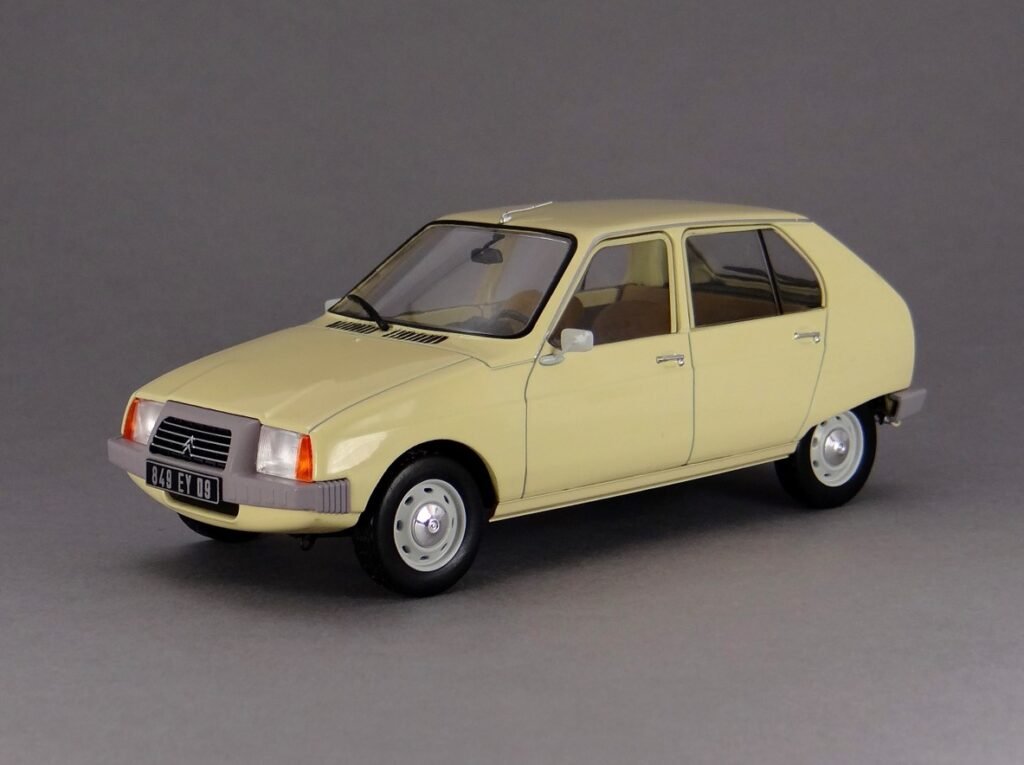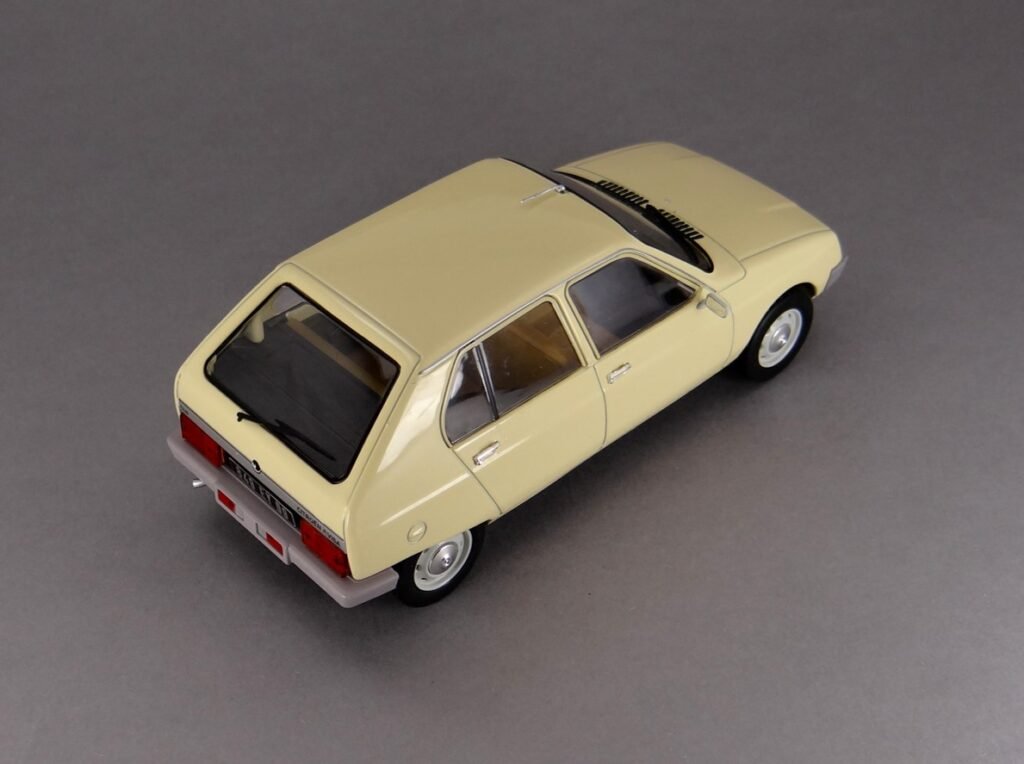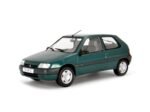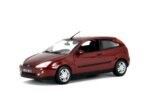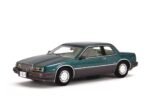Citroen Visa nie miał łatwo. Podobnie jak wiele wcześniejszych modeli producenta, musiał pokonać wiele przeszkód zanim jeszcze trafił na rynek. Ogromne kłopoty finansowe Citroena i późniejsze przejęcie przez Peugeota nadały ton tworzeniu Visy. Pomimo początkowych przeciwności, ta historia ma swój happy end.

W latach 60. Citroen stanął przed problemem – w ofercie brakowało mu nowoczesnego, małego samochodu. Model 2CV stworzony jeszcze przed II wojną światową, choć nadal niesamowicie popularny, był już wtedy przestarzały. Z kolei modele Dyane i Ami, choć z wyglądu o wiele nowocześniejsze, też bazowały na tej samej przedwojennej technice co 2CV. Od firmy która w swojej ofercie posiadała nowatorskiego DS-a oczekiwano znacznie więcej.
Dlatego też, w 1965 roku Citroen rozpoczął prace nad zupełnie nowym małym samochodem, który miał zastąpić wysłużone 2CV. Projekt nazwano G-mini, a celem było wprowadzenie go do sprzedaży w 1970 roku. Nadzór nad nim dostał Robert Opron – wtedy nowy szef działu projektowego Citroena, dla którego było to pierwsze zlecenie w firmie. Niestety, początkowe wysiłki nie zyskały aprobaty i najprawdopodobniej nigdy nie wyszły poza etap szkiców i rysunków.
Na początku lat 70. Citroen rozpoczął kolejny program projektowania małego samochodu – Prototyp Y. Typowo dla siebie, firma miała bardzo ambitne i nowatorskie pomysły względem nowego auta, ale sytuację utrudniała zła sytuacja finansowa. Aby projekt mógł być w ogóle kontynuowany, Citroen nawiązał bliską współpracę z Fiatem. Citroenowski Prototyp Y bazował więc na płycie Fiata 127 i wykorzystywał wiele z jego części mechanicznych. Pomimo zaawansowanego etapu prac, współpraca obu producentów nagle się skończyła. Citroen nie chcąc porzucić projektu, zmuszony był do stworzenia własnej platformy. To wygenerowało olbrzymie dodatkowe koszty, co w rezultacie spowodowało bankructwo Citroena.
To mógłby być koniec tej historii, ale presja francuskich polityków doprowadziła w 1974 roku do przejęcia Citroena przez Peugeota i powstania koncernu PSA. Nowe życie Citroena, oznaczało śmierć projektu Prototyp Y. Przynajmniej częśćiowo, bo platforma z tego projektu trafiła później do rumuńskiego Oltcita Club i Citroena Axela, ale to już osobna historia. W tamtym momencie, Citroen musiał po raz kolejny zupełnie zmienić plany co do swojego nowego, małego samochodu.
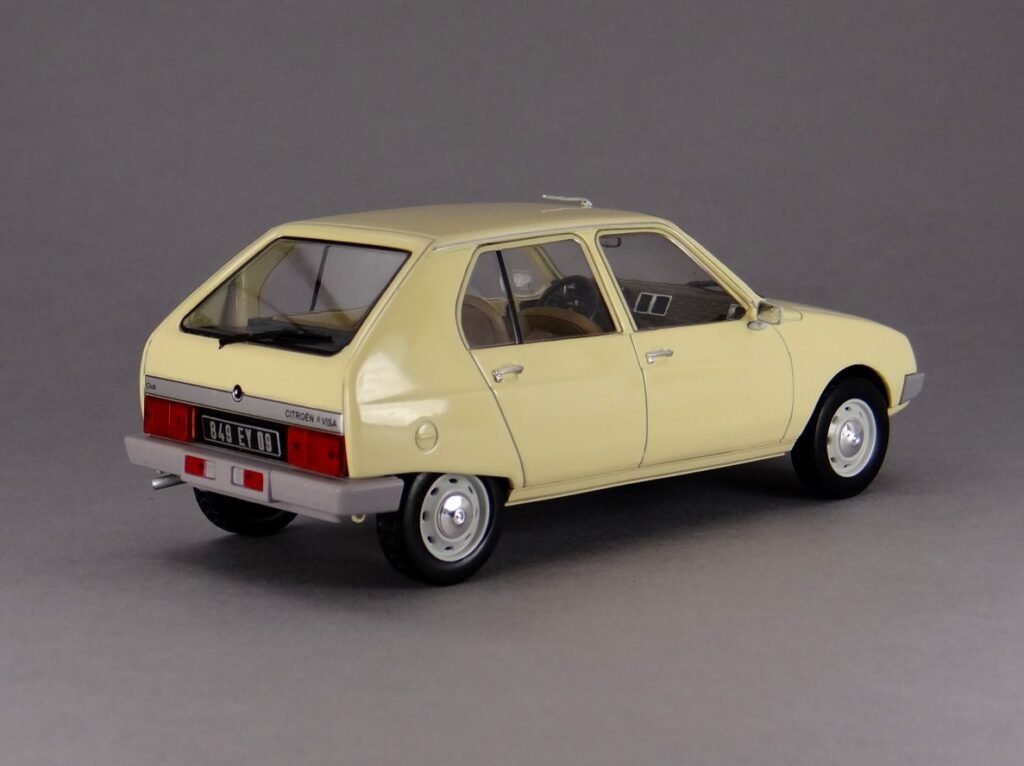
Prototyp Y przemianowano na “Projet VD (Voiture Diminuée)”, co w dosłownym tłumaczeniu znaczy “pomniejszony samochód”, lub po prostu – “mały samochód”. Nowy projekt oznaczał nowe założenia, przede wszystkim – wykorzystanie płyty, silników i skrzyni biegów z Peugeota 104.
Najprostszym rozwiązaniem byłaby oczywiście lekka modyfikacja 5-drzwiowej wersji modelu 104, ale Citroen nie chciał iść na łatwiznę. Miał już przecież w ofercie model LN/LNA który był po prostu krótką, 3-drzwiową odmianą Peugeota 104 ze znaczkiem Citroena. Kolejny model typu “badge engineering”, byłby nie do zaakceptowania zarówno przez Citroena jak i jego klientów. Firma chciała za wszelką cenę udowodnić, że pomimo przejẹcia przez Peugeota, nadal ma swój niepowtarzalny styl.
W końcu, po latach trudów i wysiłków, we wrześniu 1978 roku narodził się Citroen Visa. Nowoczesny samochód miejski którego firma tak bardzo potrzebowała, zastąpił w ofercie modele Dyane i Ami. Nowy Citroen był niezaprzeczalnie citroenowski. Już na dzień dobry kontrowersje wzbudzała stylistyka, szczególnie przedniego pasa, z ochronnymi nakładkami z odkształcalnego plastiku. Rozwiązanie dla jednych nowatorskie, dla innych najzwyczajniej brzydkie, było potocznie nazywane “świńskim ryjkiem”. Nikt nie mógł mieć jednak wątpliwości że ma do czynienia z Citroenem.
Citroenowskie szaleństwo trwało też w środku. Zamiast klasycznych przełączników, kierowca miał “satelitę” PRN (Pluie, Route, Nuit – deszcz, droga, noc), znaną już z większych modeli CX oraz GS. Pozwalało to na obsługę najważniejszych funkcji opuszkami palców, bez konieczności zdejmowania rąk z typowej dla Citroenów jednoramiennej kierownicy. Rozwiązanie wyglądało niecodziennie i takie też było w użytkowaniu, co wielu kierowcom sprawiało problemy.
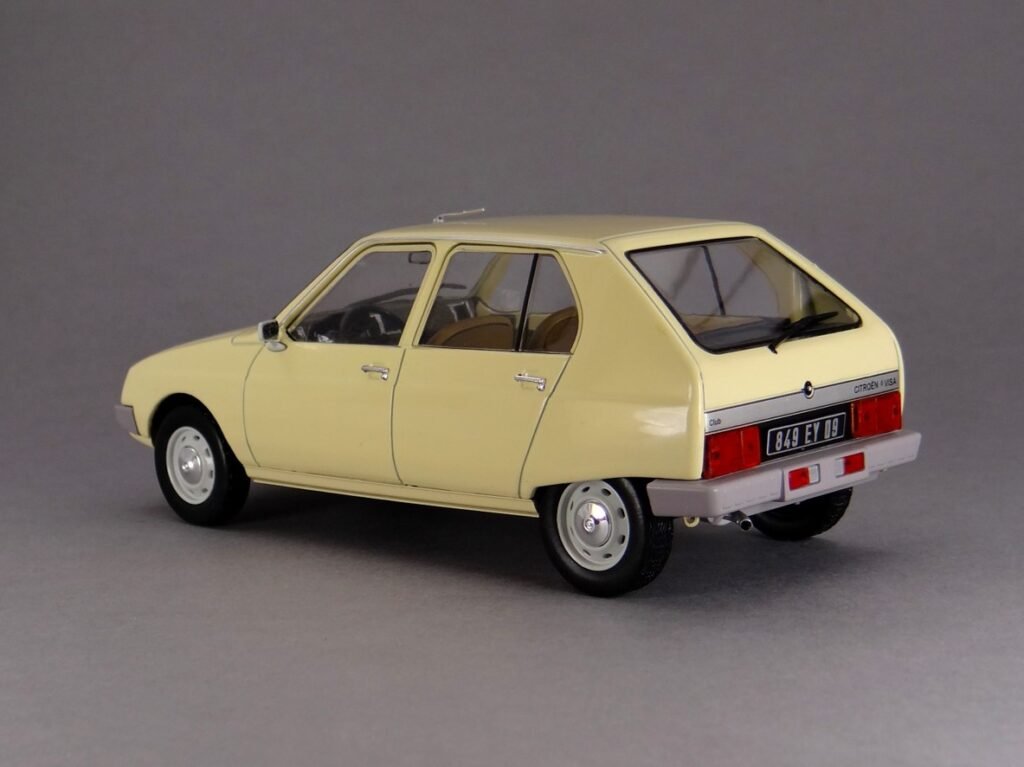
Swoją nietuzinkowość Visa przejawiała również pod maską. Początkowo oferowano tylko dwa, ale za to diametralnie różniące się od siebie silniki. W wersjach “Club” i “Spécial” był to stary, chłodzony powietrzem 36-konny dwucylindrowy, silnik typu bokser o pojemności 624ccm przejęty z 2CV, unowocześniony elektronicznym wtryskiem. Wersja “Super E” natomiast, otrzymała pochodzący z Peugeota, bardzo nowoczesny silnik czterocylindrowy o pojemności 1124 cm³. Jednostka chłodzona cieczą generowała 57 KM i była zintegrowana ze skrzynią biegów oraz dzieliła z nią układ smarowania. Ze względu na swoją konstrukcję, silnik ten musiał być montowany poprzecznie i prawie na leżąco, bo pod kątem aż 72 stopni!
Ten cały zlepek dziwactw nie uwiódł nabywców. Citroen Visa sprzedawał się kilkukrotnie gorzej od swojego największego rywala i prawdziwej francuskiej gwiazdy, czyli Renault 5. Citroen zareagował szybko i już w 1981 roku wypuścił zmodernizowaną Visę nazwaną Visa II. Za projekt modelu odpowiedzialny był fancuski producent nadwozi Heuliez. Zmiany nie były może duże, ale adresowały największe bolączki samochodu.
W nowym modelu kontrowersyjny “śwński ryjek” ustąpił miejsca większemu plastikowemu grillowi i dużym plastikowym zderzakom. Z kolei zmyślne dodatki stylizacyjne takie jak listwa na słupku C, czy nowe zespolone tylne lampy, wizualnie poprawiły dotychczas zachwiane proporcje samochodu. W środku natomiast Citroen porzucił satelitę PRN, na rzecz konwencjonalnych przełączników wziętych z Peugeota.
Zmiany w wyglądzie oraz wprowadzenie szerszej gamy silników poskutkowały znacznym zwiększeniem sprzedaży. Choć Visa nigdy nie osiągnęła pułapu Renault 5 czy Peugeota 205, to progres w porównaniu do ery “świńskiego ryjka” był ogromny. O Visach z pierwszej serii dosyć szybko zapomniano. Choć to nie dziwi, to mimo wszystko szkoda, bo to bardzo ciekawe samochody. Jedne z najoryginalniejszych w swojej klasie.
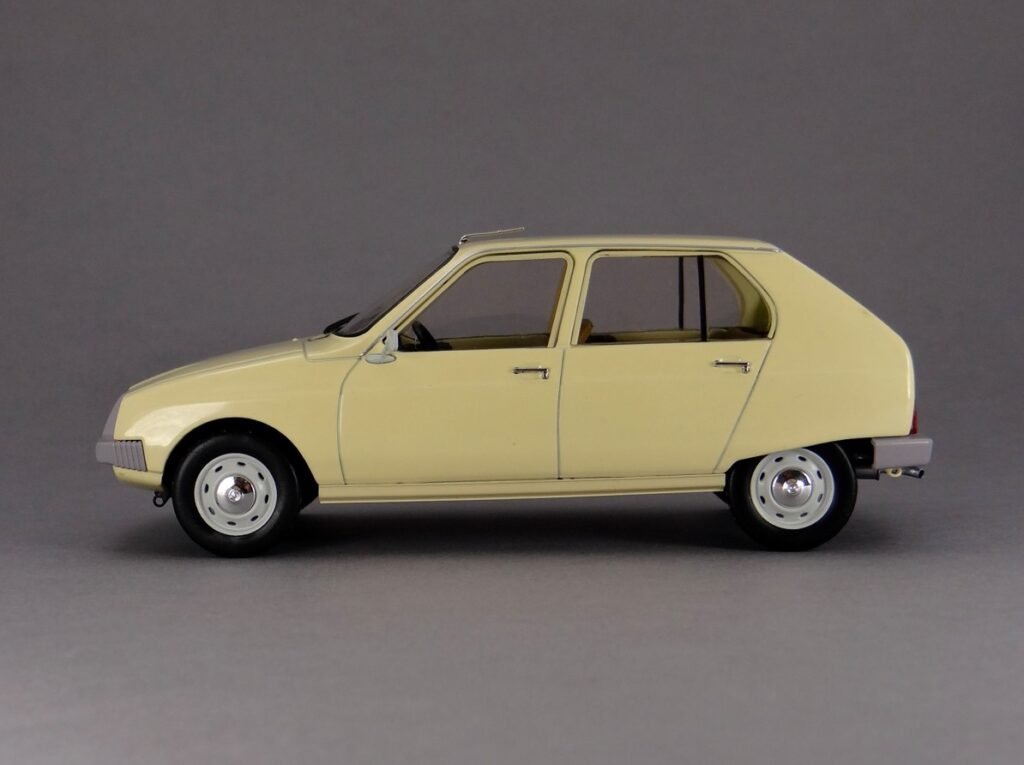
O miniaturze – Citroen Visa
Ten Citroen Visa jest w skali 1/24 i pochodzi z 49. numeru francuskiej serii “Hachette Collection Citroen”. Modelik wykonany przez PCT-IXO jest po prostu świetny. Jak przystało na tą serię, jakość wykonania nie odbiega od modeli gablotkowych. Owszem, są lekkie uproszczenia (brak głębii wlotów powietrza na masce i odbłyśników bocznych lusterek – obie rzeczy poprawiłem), ale na tyle małe, że nie psują odbioru autka.
Model nie posiada żadnych otwieranych elementów, ale nie uważam tego za wielką wadę. To jeszcze trochę zbyt mała skala, aby szczeliny między otwieranymi panelami wyglądały naturalnie. Jest więc dobrze tak, jak jest.
W tej skali dostępna jest jeszcze niebieska Visa z hiszpańskiej serii “Coches Inolvidables”. Model nie odbiega jakością od tego z francuskiej serii, więc jeśli ktoś jest zainteresowany, może śmiało brać. Tymczasem, zapraszam do oglądania Visy z “Hachette Collection Citroen“!
Zachęcam też do odwiedzania social mediów; Instagrama i Facebooka!
*** ENGLISH ***
The Citroen Visa certainly didn’t have it easy. Similarly to the brand’s many previous models, it had to overcome many obstacles before it even reached the market. Citroen’s huge financial difficulties and the subsequent takeover by Peugeot set the tone for Visa’s creation. Despite the initial struggles, this story has a happy ending.
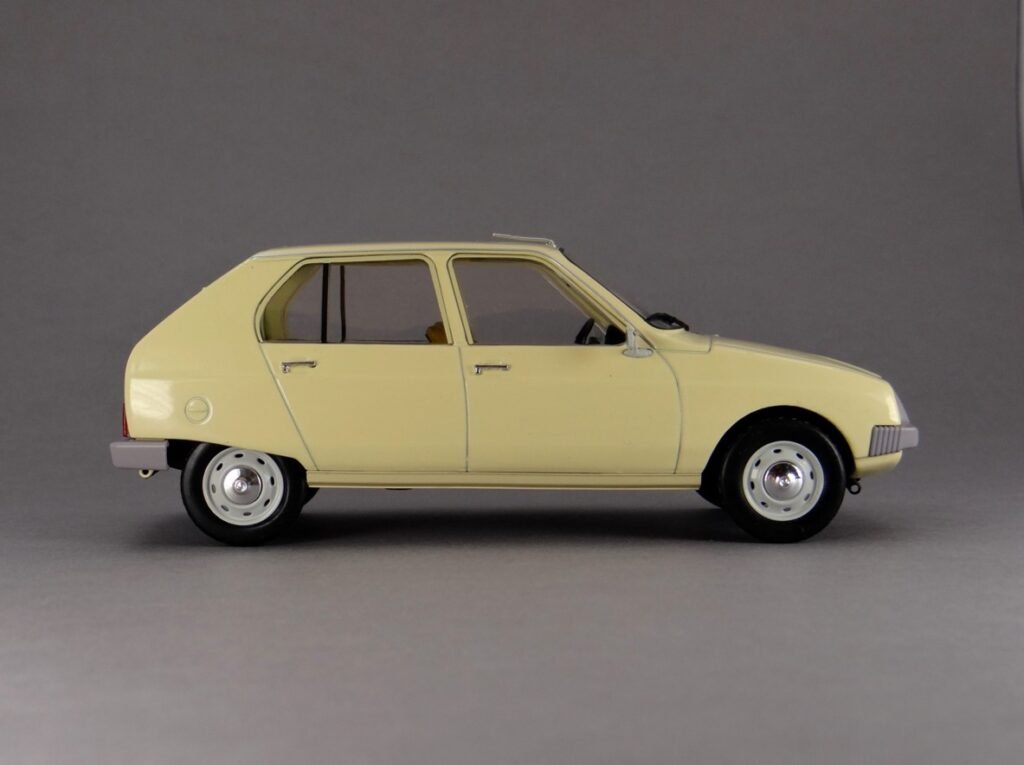
In the 60s Citroen faced a problem- it lacked a modern, small car in its line-up. The 2CV conceived before the World War II, although still immensely popular, was already outdated at the time. The Dyane and Ami on the other hand, although much more modern in terms of looks, were also based on the same pre-war technology as the 2CV. A lot more was expected from a company that offered the innovative DS.
That’s why, in 1965 Citroen began working on a brand-new, small car set to replace the old 2CV. The project was called G-mini with the aim of launching it for sale in 1970. It was supervised by Robert Opron, then the new head of Citroen’s design department, for whom this was the first task at the company. Unfortunately, the initial efforts did not gain approval and most likely, never went beyond the stage of sketches and drawings.
In the early 1970s, Citroën began another small-car design program — the Prototype Y. True to its nature, the company had very ambitious and innovative ideas for the new vehicle, but things were complicated by its poor financial situation. To be able to continue, Citroen entered into close co-operation with Fiat. As a result, Citroen based its Prototype Y on the Fiat 127’s platform and used many of its mechanical components. Despite the advanced stage of development, the collaboration between the two manufacturers suddenly ended. Not wanting to abort the project, Citroen was forced to create its own platform. This generated huge additional costs, which ultimately led to Citroen’s bankruptcy.
That could have been the end of the story, but pressure from French politicians led to Peugeot’s takeover of Citroen in 1974, resulting in the creation of the PSA Group. Citroen’s new life also meant the death of the Prototype Y — at least partially, since the platform developed for it was later used in the Romanian Oltcit Club and the Citroen Axel, but that’s another story. At that moment in time, Citroen once again had to completely change its plans for its new small car.
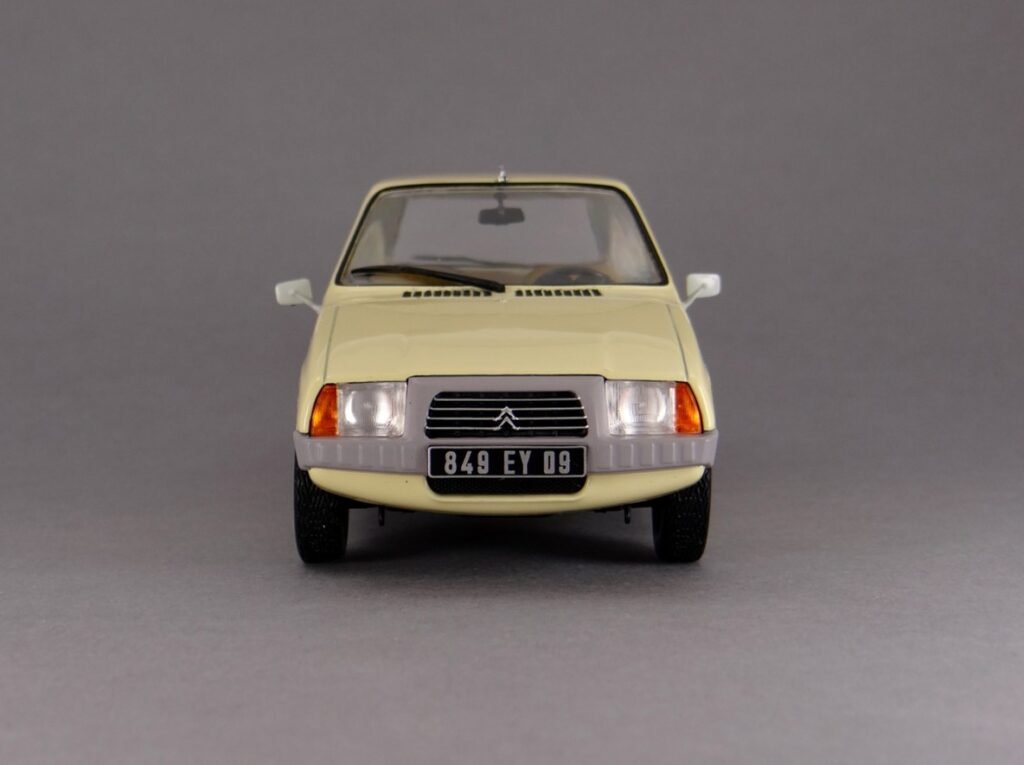
Citroen renamed its Prototype to “Projet VD (Voiture Diminuée)”, which literally means “reduced car” or simply – “small car.” A new project meant new objectives — most importantly, the use of the platform, engines and transmission from the Peugeot 104.
Citroen could, of course, have chosen the simplest solution: make slight modifications to the five-door version of the Peugeot 104. But, it didn’t want to take the easy way out. After all, it already had the LN/LNA, which was essentially a short, three-door version of the Peugeot 104 with a Citroen badge. Another “badge-engineered” model would have been unacceptable — both for Citroen and its customers. The company was determined to prove, at all costs, that despite being taken over by Peugeot, it still had its own unique style.
Finally, after years of hardships and efforts, in September 1978 the Citroen Visa was born. As a modern city car that the company so desperately needed, it replaced both the Dyane and the Ami in the lineup. The new Citroen truly was a Citroen. It sparked controversy right from the start over its styling, particularly in the front end with the protective mouldings made of deformable plastic. Innovative for some, plain ugly for others, it was nicknamed the “pig’s snout”. Love it or loathe it, nobody could have any doubt they were dealing with a Citroen.
The Citroen continued its wackiness on the inside as well. Instead of traditional switches, the driver had the PRN “satellite” (Pluie, Route, Nuit — rain, road, night), already known from the larger CX and GS models. This allowed a fingertip control of the most important functions, without having to take one’s hands off Citroën’s signature single-spoke steering wheel. The invention looked unusual — and it was just as unusual to use — which caused problems for many drivers.

The Visa also showed its quirkiness under the bonnet. Initially only two engines were offered, but they were radically different from each other. In the “Club” and “Spécial” versions, it was the old, air-cooled 36-hp two-cylinder 624ccm boxer engine, taken from the 2CV and modernized with electronic injection. The “Super E” version on the other hand, received a very modern inline-four 1124 cc engine borrowed from Peugeot. This water-cooled unit produced 57 hp and was integrated with the gearbox, sharing the same lubrication system. Because of its design, this engine had to be mounted transversely and almost horizontally— at an angle of 72 degrees!
This bundle of quirks didn’t entice the buyers. The Citroen Visa sold far worse than its biggest rival and a true French superstar, the Renault 5. Citroen reacted quickly and in 1981 released a restyled Visa, called the Visa II. The French coachbuilder Heuliez was responsible for the model’s design. The changes weren’t necessarily grand, but they addressed the car’s biggest shortcomings.
In the new model, the controversial “pig’s snout” was replaced by a larger plastic grille and large plastic bumpers. Simultaneously, clever design touches such as the trim on the C-pillars and the new rear light clusters visually corrected the previously awkward proportions of the car. Inside, Citroen abandoned the PRN satellite in favor of conventional switches borrowed from Peugeot.
Changes in the design and the introduction of a wider engine range, resulted in a big increase in sales. Although the Visa never reached the heights of the Renault 5 or the Peugeot 205, the progress compared to the “pig’s snout” era was enormous. People quickly forgot about the first series Visas. While this is no surprise, it’s still a shame, because they are very interesting cars. Quite possibly, one of the most original in the class.
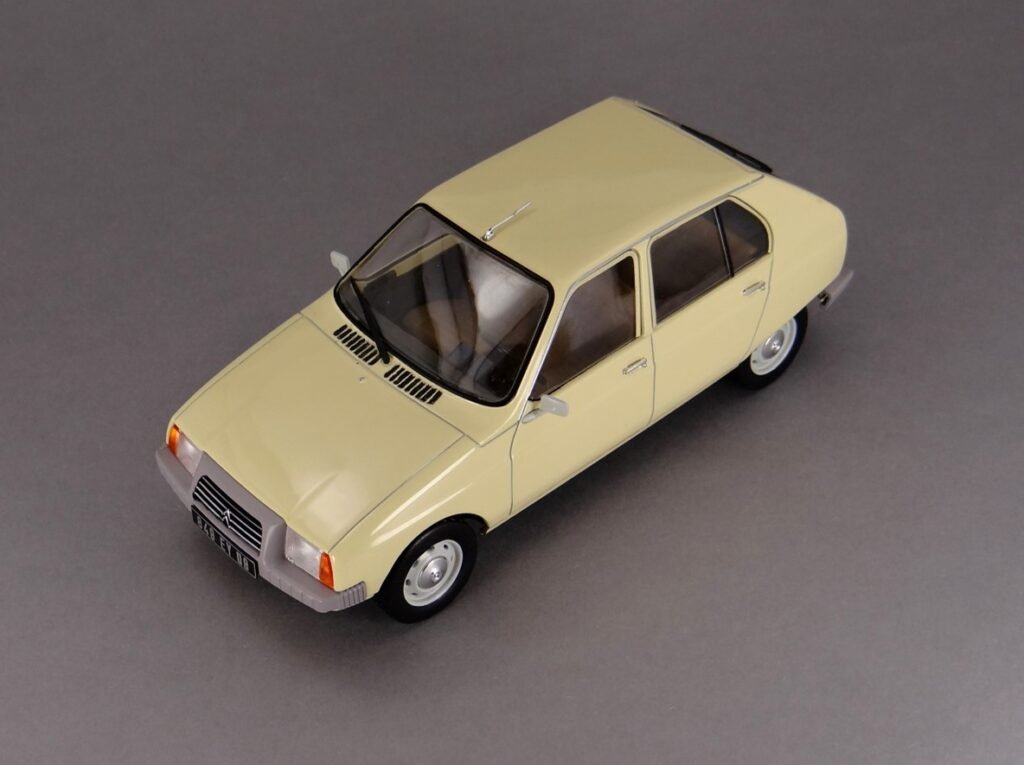
About the miniature – Citroen Visa
This Citroen Visa is in 1:24 scale and comes from no.49 of the French series “Hachette Collection Citroën”. PCT-IXO made the model and it is simply excellent. As expected from this series, the build quality is on par with branded display-case models. Of course, there are slight simplifications – body-coloured air intakes on the hood and lack of the side mirror reflectors, which I corrected. However, they’re small enough that they don’t spoil the overall impression of the model car.
The model doesn’t have any opening parts, but I don’t consider that a major flaw. This scale is still a bit too small for the gaps between opening panels to look natural. So, it’s perfectly fine the way it is.
In this scale, there is also a blue Visa available from the Spanish series “Coches Inolvidables”. The model does not differ in quality from the one from the French series, so if anyone is interested, they can go ahead and buy it. In the meantime, take a look at the Visa from the “Hachette Collection Citroën”!
Also, don’t forget to the check out the social media, Instagram and Facebook!
